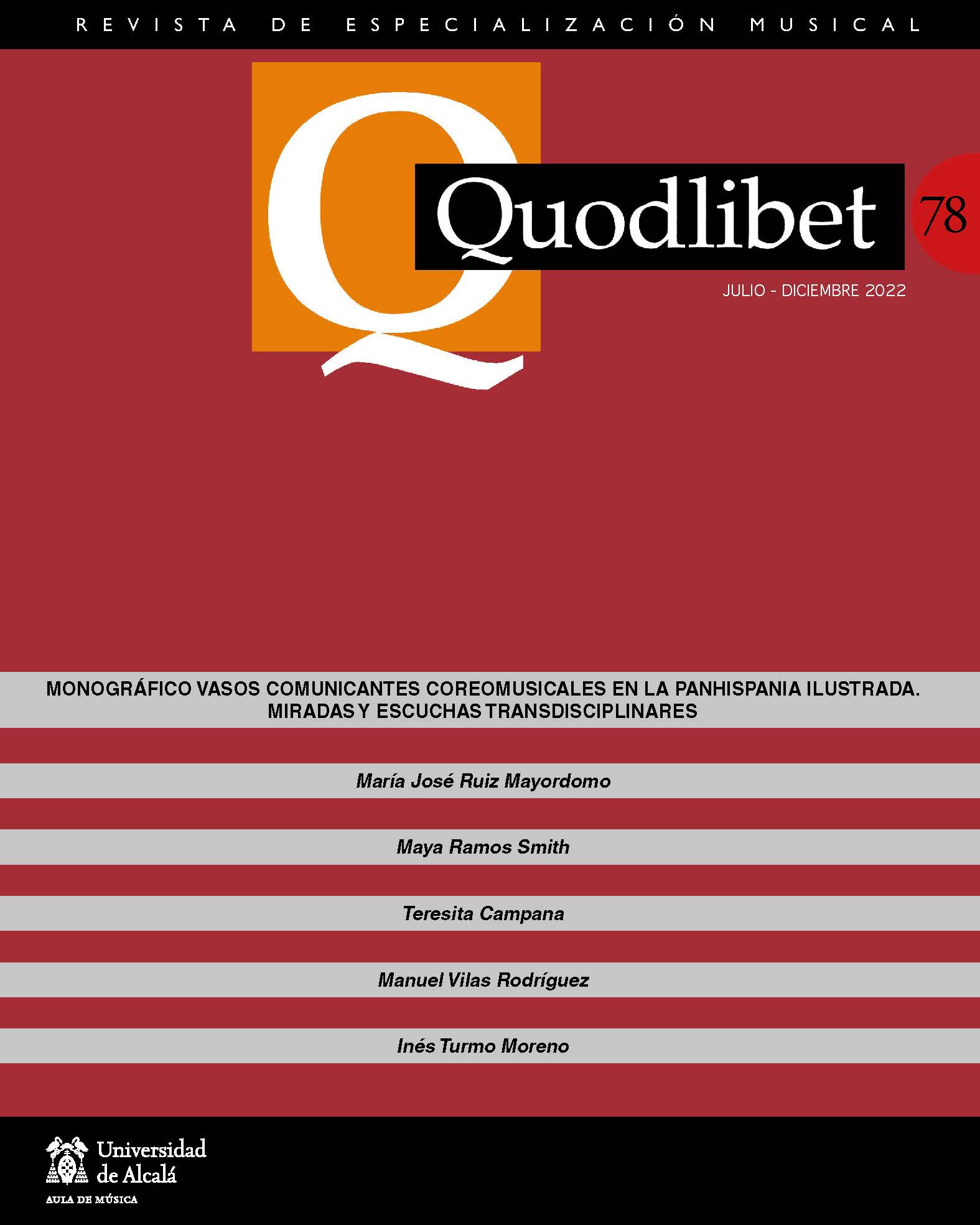IDENTITY AND OTHERNESS: THE CODEX TRUJILLO, MUSIC AND DANCES OF THE VICEROYALTY OF PERÚ DURING THE 18TH CENTURY
DOI:
https://doi.org/10.37536/quodlibet.2022.78.1984Keywords:
dances of the Viceroyalty of Peru, Early dance, 18th century, watercolours, the meeting of identities, cachuas, tonadas and bayles, courtship dances of love, Nativity dances, African dances, cultural heritageAbstract
The Codex of Trujillo, also called Codex Martínez Compañón, is a document that records the social and natural life of the Viceroyalty of Peru in the 18th century, made up of watercolours. As a body of work, it is the cultural expression of the most important and developed political entity in South America from the colonial period under the Spanish crown; that is the reason for its ethnographic and archaeological value.
Among the watercolours, dances are illustrated and there are twenty scores written in the European notation system with songs and instrumental pieces called tonadas, cachuas and bayles. To analyse this repertoire is to highlight the culture of the American late baroque period in music and dance.
This work gives an account of the basis and criteria considered when facing the task of reconstruction-recreation of dances of the past that are not written down. Through an approach methodology that articulates questions of identities/otherness, semantic fields derived from historical and cultural aspects plus the necessary approach of the diachronic axis, the extraordinary phenomenon of viceregal dance is presented and problematised.
Downloads
References
Aguilar Luna-Victoria, Carlos. La marinera, baile nacional del Perú, alcances teoréticos para la ejecución del baile de la marinera. Lima: Ministerio de Educación y Consejo Nacional de Ciencia y Tecnología, 1998.
Arbeau, Thoinot. Orquesografía. Lengres: Ichan des Preyz, 1589.
Assunçao, Fernando, Olga Latour de Botas y Beatriz Durante. Bailes Criollos rioplatenses. Buenos Aires: Editorial Claridad, 2011.
Carrión Martín, Elvira. «La danza en España en la segunda mitad del siglo xviii: el Bolero». Tesis doctoral. Universidad de Murcia, 2017.
Castro, Ricardo de. Danzas tradicionales argentinas. Buenos Aires: Ediciones del Aula Taller, 2017.
Diaz-Plaja, Guillermo. Hispanoamérica en su literatura. Navarra: Salvat Editores, 1970.
Doré, G. y Ch. Davillier. Danzas españolas. Sevilla: Bienal de Arte Flamenco y Fundación Machado, 1988.
Esquivel Navarro, Juan de. Discurso sobre el arte del danzado y sus Excelencias. Sevilla: Juan de Blas, 1642.
Estenssoro Fuchs, Juan Carlos. «Música y comportamiento festivo de la población negra en Lima colonial». Cuadernos Hispanoamericanos, n.º 451-452 (1988): 161-168.
Fernández Calvo, Diana. «La música del Obispo Baltasar Jaime Martínez Compañón». Revista del Instituto de Investigación Musicológica «Carlos Vega» 27, n.º 27 (2013): 345-410.
Goldberg, K. Meira y Antoni Pizà. The global reach of the Fandango in Music, Song and Dance: Spaniards, Indians, Africans and Gypsies. Newcastle-UK: Cambridge Scholars, 2016.
Grebe, María Ester. «Introducción al estudio del villancico en Latinoamérica». Revista Musical chilena 23, n.º 107 (1969): 7-31. https://revistamusicalchilena.uchile.cl/index.php/RMCH/article/view/10807/11060
Grut, Marina e Ivor Guest. The Bolero School. An illustrated History of the Bolero, the Seguidillas and the Escuela Bolera. Londres: Dance Books, 2002.
Macera, Pablo, Arturo Jiménez Borja, Irma Franke. Trujillo del Perú. Baltazar Jaime Martínez Compañón. Acuarelas. Lima: Fundación del Banco Continental, 1997.
Minguet é Irol, Pablo. Arte de danzar a la francesa, [...] añadido en esta tercera impression con todos los pasos o movimientos del danzar a la española. Madrid: P. Minguet, en su casa, 1758.
Moreno Muñoz, María José. «La danza teatral en el siglo xvii» Tesis doctoral. Universidad de Córdoba, 2008. Publicado el 14 de noviembre de 2008.
Nicomedes Santa Cruz. «Nicomedes Santa Cruz habla sobre el Festejo y el Landó». Video de YouTube, 2,37. Publicado el 14 de noviembre de 2008. https://www.youtube.com/watch?v=mzMx1Epjad4
Palmiero, Tiziana. «Tupamaro de Cajamarca: tonadas sobre la muerte del Inca Atahualpa contenidas en el Códice Martínez Compañón (1782-1785)». Revista Musical Chilena 65, n.º 216 (2011): 8-33. https://www.scielo.cl/scielo.php?script=sci_arttext&pid=S0716-27902011000200002
Paredes Esquives, Julio: Danza del Perú. Lima: Bendezú S.A.
Santamaría Delgado, Carolina. «Negrillas, negros y guineos, la representación musical de lo africano». Cuadernos de Música, Artes visuales y Artes escénicas 2, n.º 1 (2006): 4-20.
Sparti, Barbara. Dance, Dancers and Dance-Masters in Renaissance and Baroque Italy. Bologna: Massimiliano Piretti Editore, 2015.
Tellio, Aurelio. «La investigación de la música colonial o cómo hacer musicología rompiendo paradigmas» En Música/Musicología y colonialismo, editado por Coriún Aharonián, 235-247. Montevideo: Centro Nacional Musical Lauro Ayestarán, 2011.
Teresita campana. «Códice Trujillo o Códice Martínez Compañon de Virreinato del Perú del siglo XVIII (1782-1785)». Video de YouTube, 48:42. Publicado el 27 de noviembre de 2022. https://www.youtube.com/watch?v=DnHpm7ctp3U&t=2159s
Vega, Carlos. «La obra del Obispo Martínez Compañón». Revista del Instituto de Investigacion Musicológica «Carlos Vega» 2, n.º 2 (1978): 7-17. https://repositorio.uca.edu.ar/bitstream/123456789/1057/1/obra-obispo-martinez-companon.pdf
Vera, Alejandro. «La circulación de la música en la América virreinal: el Virreinato del Perú (siglo XVIII)». Anais do SIMPOM 3 (2014): 1-23.
Vera Basilio, Paul Orlando. «El origen de la contradanza». Culle, Revista de Sociedad y Cultura 1, n.º 2 (2021): 26-33.
Downloads
Published
Issue
Section
Categories
License
Copyright (c) 2023 Quodlibet. Revista de Especialización Musical

This work is licensed under a Creative Commons Attribution-NonCommercial-NoDerivatives 4.0 International License.










